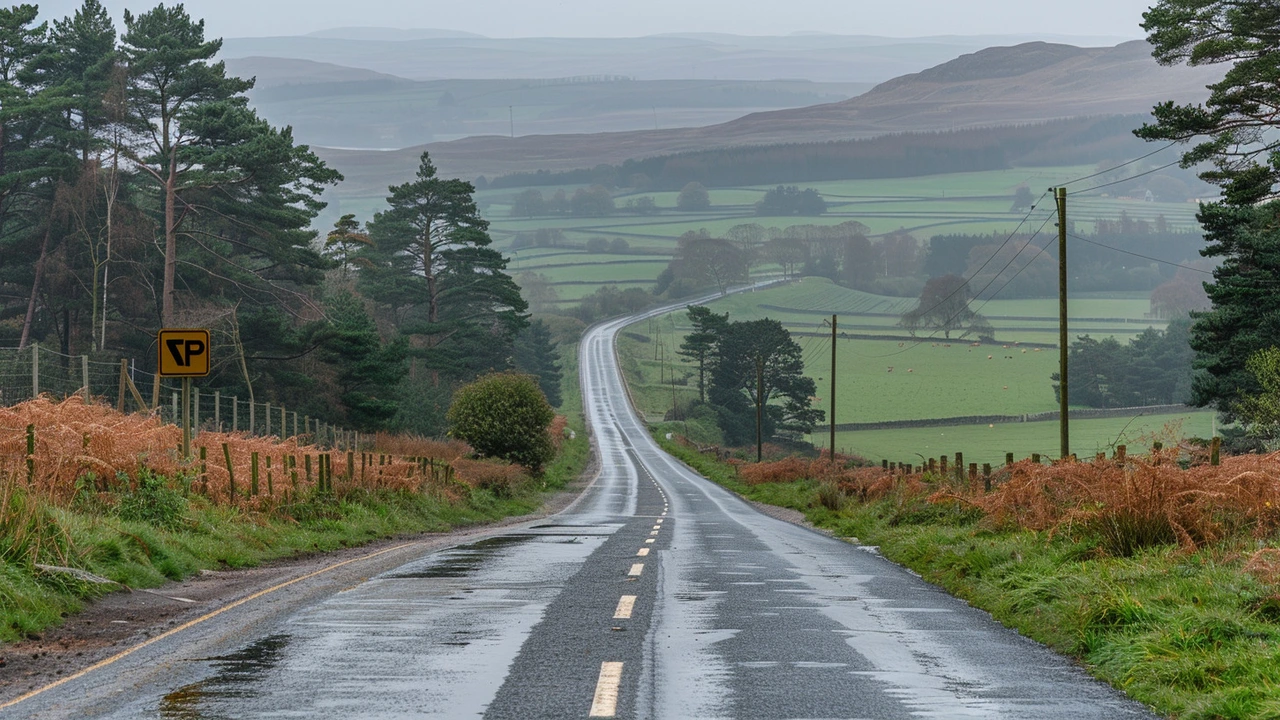Introduction: An Unlikely Connection
In the digital age, videos have a powerful way of transporting us to far-off places, revealing stories and connections we might never have imagined. A recent video is doing just that, by shedding light on the fascinating similarities between Patna in Scotland and Patna in Bihar, India. This curious connection has sparked widespread interest, leading to a deeper dive into the history and characteristics of these two geographically distant yet strikingly similar places.

Patna, Scotland: A Glimpse into the Scottish Countryside
Patna in Scotland is nestled in the East Ayrshire council area, about 45 miles away from the bustling city of Glasgow. The village is home to approximately 3,000 residents who enjoy the serene beauty of the River Doon. The landscape is marked by rolling hills, lush greenery, and quaint homes that epitomize the charm of the Scottish countryside. Established in the late 18th century, this village has a rich history.
The Scottish Patna boasts a tight-knit community with various neighborhoods, showcasing a blend of modern and traditional Scottish architecture. The roads are well-maintained, providing easy access to the nearby towns. The natural surroundings, with expansive farmland and scenic views, contribute to an idyllic lifestyle that many locals cherish. The peaceful ambiance and picturesque setting offer a stark contrast to the hustle and bustle of urban life.
Bihar's Patna: A Vibrant Indian City
On the other side of the world, Patna, the capital of the Indian state of Bihar, is a bustling metropolis with a population of over 2 million people. Located on the southern bank of the Ganges River, this city is one of the oldest continuously inhabited places in the world, with a history spanning more than two millennia. Patna has played a significant role in India's historical, cultural, and political landscape throughout the centuries.
The streets of Patna are lively and vibrant, teeming with markets, shops, and a diverse array of cultural activities. Residential neighborhoods encompass a mix of traditional Indian homes and modern high-rise buildings, reflecting the city's rapid development and urbanization. The city's infrastructure, like its Scottish counterpart, includes well-developed roads and bridges, ensuring connectivity and accessibility for its residents.
Delving into the Video: A Journey of Discovery
The video that has drawn such attention captures the essence of both Patnas with remarkable clarity. It juxtaposes the streets, homes, and natural surroundings of Patna in Scotland with those of Patna in Bihar, revealing uncanny similarities. Viewers are left in awe as they observe the parallel landscapes, particularly noting the quality of roads and the architectural styles that seem to mirror each other.
Commenters on the video have been quick to point out how astonishing it is to see such likenesses between two places that are continents apart. Beyond the roads and homes, the video also highlights the shared sense of community and the natural environments that both locations treasure. This visual comparison has sparked curiosity and appreciation for the historical bond that binds these two Patnas together.

The Historical Link: William Fullarton's Legacy
The story of how these two Patnas came to share a name is a tale rooted in history. William Fullarton, a notable figure born in India's Patna in 1774, played a decisive role in this naming tradition. As per records from Hello Travel, Fullarton relocated to Scotland where he took charge of a coal and limestone mining enterprise. In pursuit of developing a sustainable living environment for his workers, he established a village and named it Patna, paying homage to his birthplace in India.
Fullarton's initiative extended beyond merely naming a village. He demonstrated his commitment to his workers and the community by constructing infrastructure that would stand the test of time. One significant contribution was the Patna Auld Bridge, a structure built to facilitate connectivity within the village. This bridge, which served the community for 155 years, was a testament to Fullarton's vision and dedication to providing for his village. Although it was eventually replaced in 1960, its legacy remains an integral part of Patna's history.
Considering the Impact: A Tale of Two Patnas
The existence of two Patnas, one in Scotland and the other in India, offers a compelling narrative on how names and places can cross geographical and cultural boundaries. It's intriguing to contemplate how the name Patna, originating from the ancient city along the Ganges, found a new home in the Scottish countryside. This phenomenon highlights the interwoven nature of human history, where migration, commerce, and cultural exchange shape the identities of places and peoples.
For the residents of Patna in Scotland, their village's name is a point of pride, connecting them to a larger global narrative. Knowing that their small community shares its name with a bustling Indian city adds a layer of richness to their local identity. Likewise, for the inhabitants of Patna in Bihar, the existence of another Patna in Scotland serves as a reminder of their city's historical reach and the influence of its diaspora.
Embracing the Connection: Building Mutual Awareness
This newfound recognition of the link between the two Patnas holds potential for fostering mutual awareness and cultural exchange. As people in both communities learn about their shared history, there can be an increased interest in exploring each other's traditions, lifestyles, and values. Such opportunities for cultural engagement can promote greater understanding and appreciation across borders.
Educational institutions, local governments, and community organizations in both Patnas can play a pivotal role in nurturing this connection. Collaborative projects, such as student exchange programs, joint cultural festivals, and shared historical research initiatives, can help bridge the geographical divide. By celebrating their commonalities and honoring their unique histories, the two Patnas can build a partnership grounded in respect and curiosity.

Conclusion: A Shared Legacy
The video highlighting the parallels between Patna in Scotland and Patna in Bihar has opened a window into a unique, shared legacy that spans continents. It serves as a reminder of the profound ways in which human history is interconnected, transcending physical distances. This story of two Patnas is more than a tale of geographical coincidence; it's a celebration of shared heritage and a testament to the enduring nature of human connections.
As more people become aware of the bond between these two places, there is a growing opportunity to embrace and preserve this historical linkage. By honoring their common roots and fostering mutual respect, the communities of Patna in Scotland and Patna in Bihar can continue to enrich each other's lives, creating a tapestry of shared experiences that exemplifies the beauty of our globalized world.




It's fascinating how a single name can bridge two worlds, linking the misty hills of East Ayrshire with the bustling banks of the Ganges, and it reminds us that history often weaves unexpected threads, a reminder that cultures are not isolated islands, but threads in a grand tapestry, each thread adding its hue, each story enriching the whole. So when we watch that video we see more than just streets, we see a shared human curiosity, a desire to understand and be understood.
Wow, that video really amps up the sense of connection! Seeing Patna in Scotland and Patna in India side by side lights a fire under the idea that we can find kinship everywhere. It pushes us to celebrate the ties that bind rather than the miles that separate. Let's keep the momentum going and share this story far and wide!
When we look at the two Patnas, we are peering into a mirror that reflects both the constancy and the flux of human settlement. One can argue that the name itself acts like a seed, planted in distant soil, sprouting into distinct yet recognizable forms. The Scottish hills whisper of agrarian steadiness, while the Indian rivers roar with centuries of commerce and conquest. In both places, community emerges as the true architecture, not just bricks or stone. The roads may look alike, but the journeys they host differ in rhythm and purpose. This duality invites us to question what truly defines a place – is it geography, or the stories we live there? The video bridges that gap, offering a visual thesis on shared heritage. It also nudges us to consider how many other forgotten links lie in plain sight, waiting for a lens to uncover them. In a world that often highlights division, such revelations become quiet protests against isolation. So, perhaps the next step is not just admiration, but active dialogue between the two Patnas.
Honestly, the whole naming saga feels like a secret chapter hidden by colonial architects, almost as if Fullarton was planting a cultural outpost under the guise of industry-definately more than a simple homage. The Auld Bridge, for instance, could be interpreted as a symbolic conduit, weaving a covert network between empire and homeland. It's like the elite were scripting a tapestry of influence, stitching the far‑flung Patnas together to assert dominance. The drama of this hidden agenda still echoes in the stone, and one can't help but sense an undercurrent of power play that modern tourists rarely notice.
Think of this connection as a lesson in global empathy 🌍-the Scottish Patna teaches us patience, the Indian Patna shows resilience, and together they illustrate the balance we need in life. As a coach I'd say: let this story inspire you to build bridges in your own community, literally or figuratively. Embrace the curiosity, share the knowledge, and keep the positive energy flowing! 🚀
i think thats just a myth the name could be random its not a big deal
It is imperative to recognize that the Indian Patna stands as a beacon of our nation's rich heritage, unparalleled in its contribution to art, scholarship, and resistance. The Scottish counterpart, while charming, cannot eclipse the historical gravitas and cultural depth that our Patna embodies. Such comparisons should always foreground the primacy of India's civilizational legacy. Let us celebrate the achievements of our ancestors and ensure that any foreign narratives are viewed through a lens of respectful acknowledgment of our supremacy.
We can learn from each other's stories and grow together.
The juxtaposition of Patna in Scotland and Patna in Bihar serves as a compelling case study in transnational toponymy, illustrating how nomenclature travels across oceans and epochs, and it invites scholars to delve deeper into the mechanisms of cultural diffusion; indeed, the very act of naming a settlement after a far‑away metropolis reveals layers of intention, aspiration, and identity formation. One must first consider the historical context of William Fullarton, whose personal journey from the banks of the Ganges to the coalfields of Ayrshire epitomizes the human agency behind such acts, and his decision to christen a new village after his birthplace underscores a desire to transplant a piece of his heritage into foreign soil. This act, while seemingly benign, resonates with broader patterns of colonial imprinting, where the colonizer's imprints are etched onto the landscape, thereby reshaping local narratives. Moreover, the architectural parallels highlighted in the video-notably the road layouts and building silhouettes-suggest an unconscious replication of urban planning principles, perhaps driven by the settlers' familiarity with their native environment. It is also noteworthy that both Patnas have evolved distinct economic trajectories: the Scottish Patna maintaining an agrarian‑centric economy, while the Indian Patna burgeons as a commercial hub along the Ganges, thereby reflecting divergent pathways shaped by geography and policy. Yet, despite these differences, the shared sense of community emerges as a unifying thread, reminding us that social cohesion transcends physical boundaries. In educational contexts, this bilateral connection can foster interdisciplinary curricula, combining history, geography, and sociology to enrich student perspectives. Collaborative projects, such as joint heritage festivals, could further cement ties, allowing residents to exchange traditions, cuisine, and narratives, thereby humanizing distant cultures. Additionally, digital archives documenting oral histories from both locales would preserve intangible heritage for future generations. From a geopolitical standpoint, recognizing and celebrating such links can serve as soft diplomacy, subtly reinforcing mutual respect and understanding. Critics may argue that the significance of a shared name is overstated; however, the symbolic power embedded in toponyms often surpasses material realities, influencing identity construction and collective memory. Ultimately, the Patna‑Patna relationship embodies the intricate tapestry of global interconnectivity, reminding us that even the most unassuming villages are part of a vast, interwoven human story; as we continue to uncover such hidden connections, we are called upon to honor both the uniqueness and the commonality of our world.